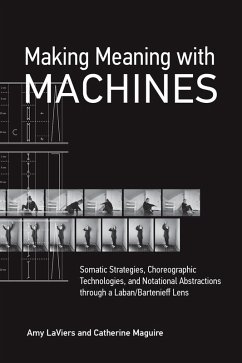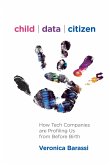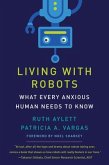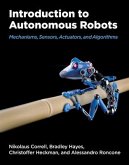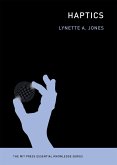Amy LaViers, Catherine Maguire
Making Meaning with Machines
Somatic Strategies, Choreographic Technologies, and Notational Abstractions through a Laban/Bartenieff Lens
Amy LaViers, Catherine Maguire
Making Meaning with Machines
Somatic Strategies, Choreographic Technologies, and Notational Abstractions through a Laban/Bartenieff Lens
- Broschiertes Buch
- Merkliste
- Auf die Merkliste
- Bewerten Bewerten
- Teilen
- Produkt teilen
- Produkterinnerung
- Produkterinnerung
"Using a well-known and successful dance and performance method, the authors describe how avatars and robots can be designed to be more comfortable with these technologies"-- Provided by publisher.
Andere Kunden interessierten sich auch für
![Child Data Citizen Child Data Citizen]() Veronica BarassiChild Data Citizen39,99 €
Veronica BarassiChild Data Citizen39,99 €![How to Grow a Robot How to Grow a Robot]() Mark H. LeeHow to Grow a Robot34,99 €
Mark H. LeeHow to Grow a Robot34,99 €![Multiagent Systems Multiagent Systems]() Multiagent Systems72,99 €
Multiagent Systems72,99 €![Living with Robots Living with Robots]() Ruth AylettLiving with Robots17,99 €
Ruth AylettLiving with Robots17,99 €![Introduction to Autonomous Robots Introduction to Autonomous Robots]() Nikolaus CorrellIntroduction to Autonomous Robots75,99 €
Nikolaus CorrellIntroduction to Autonomous Robots75,99 €![Haptics Haptics]() Lynette Jones (Massachusetts Institute of Technology)Haptics23,99 €
Lynette Jones (Massachusetts Institute of Technology)Haptics23,99 €![Living with Robots Living with Robots]() Ruth AylettLiving with Robots33,99 €
Ruth AylettLiving with Robots33,99 €-
-
-
"Using a well-known and successful dance and performance method, the authors describe how avatars and robots can be designed to be more comfortable with these technologies"-- Provided by publisher.
Produktdetails
- Produktdetails
- Verlag: MIT Press Ltd
- Seitenzahl: 418
- Erscheinungstermin: 10. Oktober 2023
- Englisch
- Abmessung: 224mm x 148mm x 29mm
- Gewicht: 512g
- ISBN-13: 9780262546126
- ISBN-10: 0262546124
- Artikelnr.: 68271190
- Herstellerkennzeichnung
- Libri GmbH
- Europaallee 1
- 36244 Bad Hersfeld
- gpsr@libri.de
- Verlag: MIT Press Ltd
- Seitenzahl: 418
- Erscheinungstermin: 10. Oktober 2023
- Englisch
- Abmessung: 224mm x 148mm x 29mm
- Gewicht: 512g
- ISBN-13: 9780262546126
- ISBN-10: 0262546124
- Artikelnr.: 68271190
- Herstellerkennzeichnung
- Libri GmbH
- Europaallee 1
- 36244 Bad Hersfeld
- gpsr@libri.de
Amy LaViers and Catherine Maguire
Preface ix
Acknowledgments xvii
Electronic Resources xix
Prelude: Opening with Embodied Perspectives 1
Introduction: Inviting Engineers into Movement Studies 3
I Making Meaning through Movement
1 Noticing Movement: Meaning, Measurement, and Experience 27
2 Studying Movement: Somatics, Choreography, and Notation 47
3 Constructing Movement: Somatic Strategies, Choreographic Technologies,
and Notational Abstractions through a Laban/Bartenieff Lens 63
II Describing Movement with an Embodied Taxonomy: The BESST System
4 What Is Moving? The Interconnection of Body Parts and Action (Body) 85
5 Where Is the Movement? Spatial Fiducials for Movement (Space) 113
6 When Is the Movement Happening? The Temporal Perception of Movement
(Time) 139
7 For Whom Is the Movement? The Relationship between Mover and Environment
(Shape) 165
8 How Is the Movement Executed? Movement Quality Enables Shading of Motion
(Effort) 185
III Translating Movement to Machines
9 Deconstructing Movement: Case Studies in Expression (Answering “Why?”)
209
10 Notating Movement: Advanced Analysis through Symbolic Representation 243
Conclusion: Understanding Movement 283
Outro: Returning to Embodied Perspectives 293
Appendix A: Symbols in the BESST System 297
Appendix B: Movement Scales 311
Appendix C: Effort Configurations 323
Appendix D: Rationale for the Time Component 327
Appendix E: Pedagogy and Group Work 329
Glossary 339
Notes 359
References 367
Index 383
Acknowledgments xvii
Electronic Resources xix
Prelude: Opening with Embodied Perspectives 1
Introduction: Inviting Engineers into Movement Studies 3
I Making Meaning through Movement
1 Noticing Movement: Meaning, Measurement, and Experience 27
2 Studying Movement: Somatics, Choreography, and Notation 47
3 Constructing Movement: Somatic Strategies, Choreographic Technologies,
and Notational Abstractions through a Laban/Bartenieff Lens 63
II Describing Movement with an Embodied Taxonomy: The BESST System
4 What Is Moving? The Interconnection of Body Parts and Action (Body) 85
5 Where Is the Movement? Spatial Fiducials for Movement (Space) 113
6 When Is the Movement Happening? The Temporal Perception of Movement
(Time) 139
7 For Whom Is the Movement? The Relationship between Mover and Environment
(Shape) 165
8 How Is the Movement Executed? Movement Quality Enables Shading of Motion
(Effort) 185
III Translating Movement to Machines
9 Deconstructing Movement: Case Studies in Expression (Answering “Why?”)
209
10 Notating Movement: Advanced Analysis through Symbolic Representation 243
Conclusion: Understanding Movement 283
Outro: Returning to Embodied Perspectives 293
Appendix A: Symbols in the BESST System 297
Appendix B: Movement Scales 311
Appendix C: Effort Configurations 323
Appendix D: Rationale for the Time Component 327
Appendix E: Pedagogy and Group Work 329
Glossary 339
Notes 359
References 367
Index 383
Preface ix
Acknowledgments xvii
Electronic Resources xix
Prelude: Opening with Embodied Perspectives 1
Introduction: Inviting Engineers into Movement Studies 3
I Making Meaning through Movement
1 Noticing Movement: Meaning, Measurement, and Experience 27
2 Studying Movement: Somatics, Choreography, and Notation 47
3 Constructing Movement: Somatic Strategies, Choreographic Technologies,
and Notational Abstractions through a Laban/Bartenieff Lens 63
II Describing Movement with an Embodied Taxonomy: The BESST System
4 What Is Moving? The Interconnection of Body Parts and Action (Body) 85
5 Where Is the Movement? Spatial Fiducials for Movement (Space) 113
6 When Is the Movement Happening? The Temporal Perception of Movement
(Time) 139
7 For Whom Is the Movement? The Relationship between Mover and Environment
(Shape) 165
8 How Is the Movement Executed? Movement Quality Enables Shading of Motion
(Effort) 185
III Translating Movement to Machines
9 Deconstructing Movement: Case Studies in Expression (Answering “Why?”)
209
10 Notating Movement: Advanced Analysis through Symbolic Representation 243
Conclusion: Understanding Movement 283
Outro: Returning to Embodied Perspectives 293
Appendix A: Symbols in the BESST System 297
Appendix B: Movement Scales 311
Appendix C: Effort Configurations 323
Appendix D: Rationale for the Time Component 327
Appendix E: Pedagogy and Group Work 329
Glossary 339
Notes 359
References 367
Index 383
Acknowledgments xvii
Electronic Resources xix
Prelude: Opening with Embodied Perspectives 1
Introduction: Inviting Engineers into Movement Studies 3
I Making Meaning through Movement
1 Noticing Movement: Meaning, Measurement, and Experience 27
2 Studying Movement: Somatics, Choreography, and Notation 47
3 Constructing Movement: Somatic Strategies, Choreographic Technologies,
and Notational Abstractions through a Laban/Bartenieff Lens 63
II Describing Movement with an Embodied Taxonomy: The BESST System
4 What Is Moving? The Interconnection of Body Parts and Action (Body) 85
5 Where Is the Movement? Spatial Fiducials for Movement (Space) 113
6 When Is the Movement Happening? The Temporal Perception of Movement
(Time) 139
7 For Whom Is the Movement? The Relationship between Mover and Environment
(Shape) 165
8 How Is the Movement Executed? Movement Quality Enables Shading of Motion
(Effort) 185
III Translating Movement to Machines
9 Deconstructing Movement: Case Studies in Expression (Answering “Why?”)
209
10 Notating Movement: Advanced Analysis through Symbolic Representation 243
Conclusion: Understanding Movement 283
Outro: Returning to Embodied Perspectives 293
Appendix A: Symbols in the BESST System 297
Appendix B: Movement Scales 311
Appendix C: Effort Configurations 323
Appendix D: Rationale for the Time Component 327
Appendix E: Pedagogy and Group Work 329
Glossary 339
Notes 359
References 367
Index 383

